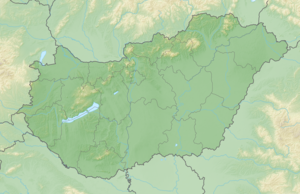Rákóczi Castle
| Rákóczi Castle | ||
|---|---|---|
|
Aerial view of the Rákóczi Castle |
||
| Alternative name (s): | Rákóczi-vár, Pataki vár, Sárospatak Castle |
|
| Conservation status: | receive | |
| Place: | Sárospatak | |
| Geographical location | 48 ° 18 ′ 55 " N , 21 ° 34 ′ 7" E | |
|
|
||
The Rákóczi Castle in Sárospatak is one of the most famous castle and palace complexes in Hungary . It consists of a mighty residential tower redesigned in the style of the Renaissance and a four-sided palace complex with stylistic elements of the Baroque and Rococo .
location
Rákóczi Castle is located above the Bodrog River in the southeast of Sárospatak.
history
The medieval complex came into the possession of the Barone Perényi in the 16th century . From 1534, Péter Perényi had the mighty residential tower - called the Red Tower - built together with the fortifications. Under his son Gábor, who died in 1567 without any descendants, the complex was expanded to include the palace , which has now opened in the east wing of the palace .
After disputes, Sárospatak and the castle came into the possession of the Dobó family in 1573 and the Lorántffy family in 1606 . She had what is known today as the Lorántffy Loggia connecting the tower and the castle.
In 1616 the castle became the property of the Rákóczi family, who served it as their seat for almost a hundred years. After his appointment as Prince of Transylvania in 1630, Georg I. Rákóczi (1593–1648) had the castle expanded and decorated in a representative manner and expanded to include the western, southern and northern wing of the castle. After the death of his son Georg II. Rákóczi (1621–1660), the castle was given up as a family property and fell into disrepair.
In 1803 the rule of Sárospatak including the castle came to Karl August Friedrich Joseph von Bretzenheim as compensation for the city of Lindau, which had been ceded to Austria . Under the Bretzenheimers, Rákóczi Castle received its present-day character in the 19th century, the main facade was redesigned in the neo-Romanesque style, and an English-style landscape park was created on the walls and moats .
In 1875 the castle came into the possession of the imperial princes of Windisch-Grätz . They arranged for a St. Elisabeth chapel to be set up in the Red Tower in honor of St. Elisabeth of Thuringia , who may have been born in the castle.
St. Elisabeth Church
Within the castle walls is the St. Elisabeth Church , a mighty late Gothic hall church from the 14th century. The baroque altar comes from the Carmelite Church in Buda .
Todays use
Today the Rákóczi Museum is located in the castle . The rooms with their original furnishings from the Renaissance and Biedermeier periods show the history of the Rákóczi princely family and the castle. In the tower there is a bay room, the so-called Rose Hall (after the rose-shaped keystone of the vault). In 1664 the leaders of the magnate conspiracy against Emperor Leopold I of Habsburg are said to have gathered here.
The largest wine cellar in Hungary can also be visited on the grounds of the outer fortress, along with an exhibition on the history of viticulture in the Tokaj wine region .
See also
literature
- Steve Fallon, Neal Bedford: Hungary. Ostfildern, Lonely Planet, 2006. ISBN 3-8297-1570-6

